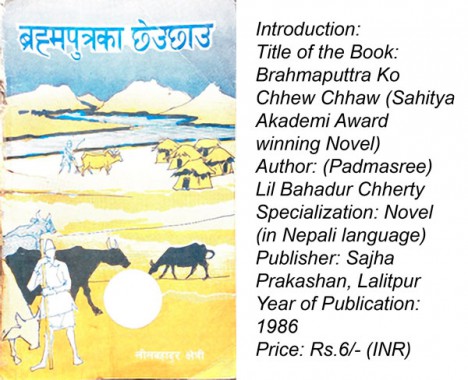




















Monday, Mar 30, 2020 12:30 [IST]
Last Update: Monday, Mar 30, 2020 06:58 [IST]
ANJAN BASKOTA
(Padmasree) Lil Bahadur Chhetry, a glittering star of the Indian Nepali literature was born on 1st March 1933 at Guwahati. Prem bahadur was his father and Pabitra Devi was his mother. Sri Chherty was the first ever Nepali literature and educationist to be selected for the covetus civilian award ‘Padmasree’ from the N.E region. Retired professor of glamorous Arya Vidyapeeth college, Sri Chhetry’s widely read novels are ‘Basein’ (1957), ‘Brahmaputtra Ko Chhew Chhaw’ (1986), ‘Atripta’ (1968) and ‘Pratidhwaniharu Bismritika’ (2004). His other well-known creations are ‘Asam ma Nepali Bhasak Sarogaro’, ‘Dobato’, ‘tin Dasak Bish Abhibyakti’ etc. The novel ‘Basein’ by Sri Chhetry has been included in the curriculum of the Tribhuwan University of Nepal. Sri Chhetry received Sahitya Akademy awrd in 1987 for his novel ‘Brahmaputtra Ko Chhew Chhaw’. In 2016 he has received ‘Jagadambasree’ award. And in 2019 he was awarded with ‘Basudev Malati International Award’ for his outstanding contribution in the field of literature and education.
Brahmaputtra Ko Chhew Chhaw: an analysis:
The Sahitya Akademy award winning novel which came to light in 1986 has been composed on the theme of the struggle of the Nepali people of various parts of India with especial focus on Assam. How the Nepalese from neighboring nation Nepal entered into various provinces of then India and N.E region, what are the root causes that compelled the Nepalese to leave their motherland etc have been highlighted and widely discussed.
The story of the widely read novel develops with a story of a layman who left his motherland i;e Nepal and set out in search of a secure place to live in and to survive with dignity. Manbir and Jurely, the husband and wife who hardly heard a little about Assa and N.e region reached Assam. The newly arrived couple who hardly knew the directions of the new state met a land lord in the railway station who was there in search of maid servants for his dairy firm. The man was none other than the ‘dairy Mahajan’ who has a well repute, establishment in his locality. Manbir and Jureli agrees to work for dairy mahajan and followed him who on return would run Manbir’s family. Gumansingh was born to them as their first child.
The novel was written during the crucial period of world war II and in the peak hours of India’s freedom movement. Vivid images like how the British govt. recruited the Gorkha Jawans in the British regiment and how dedicately they fought against the German are shortly sketched. Simultaneously the influence f India’s freedom movement that had touched the general mass of the Nepali community along with other Indians is nicely pictured. The cow herd keeper’s, peasants, farmers of rural areas have been seen indulging in different activities of freedom movement.
The main character of the novel Gumansingh has lost his parents at his early age. The moment he becomes orphan the dairy mahajan has offered him to stay with him. But Guman has denied his offer as the dairy mahajan is an exploiter who uses to exploit the poor by offering high rate of interest and by capturing their crop lands etc. On the contrary Guman decides to live with Kakati Babu; a prominent Assamese teacher, a Gandhian freedom fighter and a social reformer of the nearby village. There is an another reason behind his choice. Manbir; father of Guman just beore his death had made a request to Kakati Babu to look after his son. Like way, one day he followed Kakati Babu to his home and stayed there. Being in his house he has attained his higher education.
The main story of the novel revolves round the central character Gumansingh and his struggle for survival. After attaining higher education Guman has tried in many venture schools as an honorary teacher and in dairy firm of Dairy Mahajan. But Guman fleed away from Mahajan’s frim because the later trapped Guman and forced him to engage with his daughter in a marriage ceremony. But Guman who is in love with Kakati Babu’s daughter Malati ran away from the dairy firm and joined in the Indian Army. Malati who has been separated from Guman waits eagerly for her beloved’s return. After joining the Army Guman has made only one or two contacts with Malati. But after a prolonged gape and uncertainty about whereabouts of Gumansingh, Kakati Babu’s family has arranged Malati’s marriage with a doctor. Malati’s married life has become neither fruitful no happy at all. In the mean time, Guman has returned to his native village after being handicapped in a battle. Guman has dedicated hi later life in social service and for upliftment of his society missing his beloved Malati.
The Brahmaputtra river and its basin, the settlement on the both sores of the mighty river, the way of life, different customs, traditions, culture are nicely knitted in the novel. Mutual understanding, cooperation of the Assamese and the Nepali society has been depicted well.
Novelist Chhetry tries to highlight various issues of the Nepalese like the issue of ‘D’ voters, graziers land, land and revenue related problems, road and communication, education etc through the novel. A compact picture of the then Nepali society who engaged themselves only in animal husbandry, dairy farming and agriculture is well depicted here in the novel. In addition to that historical, social, religious, cultural, political and ethnic diversities of the greater region are finely and vividly described.
Conclusion:
In my view, it is one of the finest novel, I ever read. It is the finest novel in many reasons. Some of the reasons are cited below-
1. Prof. Chhetry tries to establish newly coined Assamese-Nepali words in the field of Nepali literature.
2. The language used here is so simple and easy that any reader of the source language could understand it.
3. Though the novelist has used many Assamese-Nepali words widely yet he has not forgotten to provide foot notes for its global understanding.
4. The mighty Brahmaputtra which is regarded as the cause of sorrow and happiness of the Assamese plays a significant role in the novel.
5. The novel is fictitious yet it highlights socio-political and historical aspects of the Nepalese and their settlement in this region.
Foot Note:
1. The Assam Tribune (An English daily published from Assam, India), page: 11, dtd. 11th February 2020.
2. Cover page (by the blogger).
